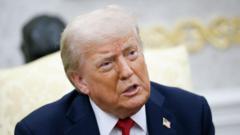Will Trump's Tariff Threats to Russia Change the Ukraine Weapons Game?

US Military Support for Ukraine: An Overview of Recent Developments
In a significant announcement, former President Donald Trump has outlined a robust military support plan for Ukraine, emphasizing the need for "top-of-the-line weapons" to bolster the country's defenses against Russian aggression. This decision comes on the heels of a meeting with NATO chief Mark Rutte in Washington, where both leaders discussed the strategic implications of further military assistance to Ukraine. Alongside the military support, Trump has threatened to implement severe tariffs on Russia's trade partners if a peace deal is not reached within the next 50 days. This article delves into the details of this military aid, the implications of the proposed tariffs, and the broader geopolitical context surrounding these developments.
The Military Aid Package: What’s in Store for Ukraine?
The announcement by Trump and Rutte highlighted a commitment from the United States to provide Ukraine with critical military resources. While specific details regarding the type of weaponry were not disclosed, Rutte confirmed that European nations would be supplying their own Patriot air defense systems to Ukraine. In turn, the U.S. would replace these systems, ensuring that European countries are equipped to assist Ukraine effectively. This collaborative effort underscores the strong unity within NATO regarding the support for Ukraine.
Key Components of the Military Aid
- Patriot Air Defense Systems: Vital for repelling air strikes, these systems have become essential in safeguarding Ukrainian airspace.
- Missiles and Ammunition: Rutte indicated that the package would include various missiles and munitions, enhancing Ukraine's offensive and defensive capabilities.
- Top-of-the-Line Weapons: Trump emphasized the importance of advanced weaponry, stating that these resources would be "quickly distributed to the battlefield."
The focus on high-quality military equipment reflects an understanding of the escalating conflict and the need for Ukraine to maintain its sovereignty and territorial integrity. The international community's backing, particularly from NATO members, remains crucial as Ukraine faces ongoing threats from Russia.
The Economic Strategy: Tariffs on Russia's Trade Partners
In addition to military support, Trump has proposed a bold economic strategy aimed at pressuring Russia through trade tariffs. The plan includes imposing a 100% secondary tariff on countries that continue to engage in trade with Russia if a peace agreement is not reached within a specified timeframe. This measure is intended to create significant economic consequences for nations that maintain trade relations with Russia.
How the Tariffs Would Work
The proposed tariffs would directly impact countries that import oil and gas from Russia. For instance, if India continues to purchase Russian oil, any goods exported to the United States from India would incur a 100% import tax. This would make Indian products prohibitively expensive for U.S. businesses, potentially leading them to seek cheaper alternatives from other nations. The intention behind this strategy is to cripple Russia's economy by reducing its revenue from oil exports, which account for a substantial portion of its state income.
Potential Economic Impact
- Loss of Revenue for Russia: With oil and gas representing over 60% of Russia's exports, the tariffs could significantly hinder the Kremlin's financial capabilities.
- Economic Repercussions for Trade Partners: Countries that rely on Russian energy may face economic strain as they navigate the tariffs imposed by the U.S.
- Global Market Shifts: The tariffs could lead to shifts in global trade patterns, with countries seeking alternative energy sources and suppliers.
This economic strategy serves a dual purpose: it aims to weaken Russia's financial resources while encouraging other nations to reconsider their trade relationships with the Kremlin.
The Geopolitical Context: A Shift in Rhetoric
Trump's recent statements mark a notable shift in his approach to Russia and Ukraine. Historically, his administration maintained a more conciliatory tone towards Putin, but the current rhetoric appears to reflect a growing frustration with Russia's actions. Trump's acknowledgment of the need for action rather than mere dialogue signals a more aggressive stance in dealing with the ongoing conflict.
The Complexity of U.S.-Russia Relations
U.S.-Russia relations have long been complicated, and Trump's comments further illustrate the challenges faced in seeking a resolution to the Ukraine conflict. While he expressed a willingness to engage in discussions with Putin, his frustration with the lack of tangible progress is palpable. This duality of dialogue and action reflects the intricate nature of diplomacy in a time of war.
Implications for NATO and the International Community
The commitment to support Ukraine through military and economic measures reinforces NATO's unity and determination to counter Russian aggression. As European nations step up their contributions, the message sent to Moscow is clear: the international community stands behind Ukraine. The collaboration among NATO members highlights the importance of a collective defense strategy in addressing security threats.
Challenges Ahead: The Road to Peace
Despite the increased military support and economic pressure on Russia, achieving peace in Ukraine remains a complex and challenging endeavor. Previous ceasefire talks have yielded little progress, and the current geopolitical climate adds layers of difficulty to the negotiation process. The lack of scheduled meetings between Russia and Ukraine indicates the need for renewed efforts to facilitate dialogue and find common ground.
What Lies Ahead for Ukraine?
- Increased Military Engagement: As the conflict continues, Ukraine may need to rely on enhanced military support to defend its territory and maintain sovereignty.
- International Diplomatic Efforts: The role of international mediators and diplomatic channels will be critical in facilitating negotiations between the conflicting parties.
- Public Sentiment and Support: The ongoing conflict has galvanized public support for Ukraine, which may influence future policy decisions by governments around the world.
The coming weeks will be pivotal in determining the trajectory of the conflict and the international response to Russia's actions. As the situation evolves, the emphasis on military readiness and economic pressure will likely continue to shape the discourse surrounding Ukraine's future.
Conclusion: A Call for Action and Reflection
The recent developments surrounding U.S. support for Ukraine and the proposed tariffs on Russia's trade partners highlight the complexities of international relations in a time of conflict. As the situation unfolds, it is essential for the global community to stay informed and engaged in the pursuit of peace and stability. The commitment to support Ukraine through military and economic measures underscores the importance of unity among nations in addressing security threats.
As we reflect on these developments, one must consider: How can the international community work together more effectively to promote peace and stability in Ukraine and beyond?
Frequently Asked Questions
What type of weapons is the U.S. sending to Ukraine?
The U.S. has committed to supplying "top-of-the-line weapons," including Patriot air defense systems, missiles, and ammunition, through NATO countries to support Ukraine's defense efforts.
What are the proposed tariffs on Russia's trade partners?
Trump has proposed a 100% secondary tariff on countries that trade with Russia if a peace deal is not reached within 50 days, which would significantly raise the cost of goods exported to the U.S. from those countries.
How will the tariffs affect global trade?
The tariffs could lead to shifts in global trade patterns, as countries may seek alternative suppliers to avoid the increased costs associated with trading with Russia.
What challenges does Ukraine face in achieving peace?
Ukraine faces numerous challenges in achieving peace, including the lack of scheduled negotiations, the ongoing military conflict, and the complex geopolitical landscape involving various international stakeholders.
As the situation in Ukraine continues to evolve, it's vital to consider how international unity can pave the way for lasting peace. #UkraineSupport #NATOStrength #GlobalUnity
Published: 2025-07-14 18:13:04 | Category: world



